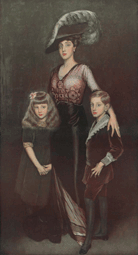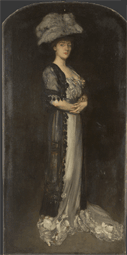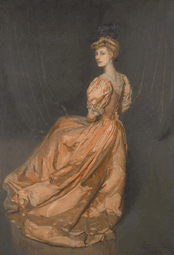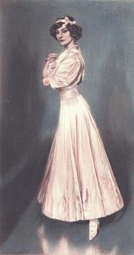






 From Paris to …
From Paris to …
From Domergue, Gabriel
December, 1910
"Antonio de La Gandara
If it be true, as Balzac affirmed, that the name has a preponderant influence upon the destiny of its bearer then there is nothing astonishing that that of La Gandara should be known as the recognised portraitist of the most elegant and aristocratic gentlewomen.
From the romantic consonance of this name one is tempted to think that it belonged to some great lord of the court of Philip IV and the time of Velasquez. However La Gandara is essentially of the present and it is as dear to him as the rich legacy of the past. All which is beautiful attracts and holds him, and by that same quality he attaches art-lovers to himself.
It is matter of history that past and present have seen very dire early struggles of those who have won both wealth and fame. La Gandara also had a hard apprenticeship under Dame Fortune but won through to celebrity by will-power and talent.
As a child the clever portraitist remembers having been more often than not comfortably nestled on his father’s knees whilst the latter sketched in some of his clever landscapes. Small wonder therefore that the son followed his father’s profession, and we find him entering Gérôme’s studio at the Beaux-Arts when but fourteen years of age. His early successes made him desirous of competing for the Prix de Rome, but being of foreign origin he was inadmissible much to his regret.
Born of a Spanish father and English mother, Paris counts him one of her own adopted, although the rules of the Ecole des Beaux-Arts prevented him taking part in their competitions. In the masterly handling of his brush La Gandara proves himself allied to Velasquez and to Gainsborough, for there is both imposing beauty and proud grace in his portraits. The Salon des Artistes Français accepted and hung his Saint-Sébastien sent at the age of seventeen, entirely on his own initiative.
Emboldened by his success La Gandara followed it up by a portrait which received an honourable mention. Thenceforth he had only to boldly continue his way to renown. Suddenly he ceased to exhibit, for, with the wisdom of genius he felt time must be given to evolve that which was working within him.
With the patience of an Oriental he waited the striking of his hour which delayed not its coming. The exhibition of 1899 gave rise to a wish to organise something apart from the “Société des Artistes Français”. Several artists of standing broke with the Société and founded a new group, the “Société du Champ de Mars” whose aim was to foster every free attempt at art manifestation and to enrol as members those having already given proof of progressive talent. La Gandara’s hour was come. Cazin went to him and asked him to join the new brotherhood.
Much at home in this circle where all efforts had a free course he did not hesitate to follow the bent of his aspirations. His success was remarkable. Enthusiastically elected member and associate he yearly exhibited with an unvarying felicity.
The first important portrait he exhibited was that of the Marquise Jean de Montebello. It pleased everybody and definitively added La Gandara’s name to those of Velasquez, Gainsborough and Whistler.
M. Tristan Klingsor, the critic, wrote after one of the artist’s successful exhibitions. "Cette prédilection pour l’impression choisie, l’artiste la transporte également dans ses portraits. C’est là qu’il est incomparable. Il sait l’indéfinissable et captivant intérêt qui se dégage des lignes d’un visage; pour lui, il n’y a sans doute pas de paysage qui puisse rivaliser d’expression avec une tête humaine, de mystère avec une main oisive, de grâce avec un corps de femme. Il sait que rien n’est impressionnant comme ces personnages immobiles et muets, mais vivants. Et ils vivent. Ce ne sont plus les souffreteuses apparitions des préraphaélistes, les femmes de légende au charme un peu convenu d’une peinture de rêve. Non. Les personnages de La Gandara vivent vraiment dans une réalité exquise et discrète. Avant tout ce sont des êtres de 'race'. Il y a de la nervosité élancée du lévrier en eux. La fraîcheur des lèvres et des joues, la délicatesse du nez et des oreilles, l’ovale des fronts, l’exiguïté des mentons, la minceur du cou et des poignets, la féminité des mains surtout, la distinction voulue du geste et de l’attitude, tout cela les marque d’une élégance aristocratique et pure. Et c’est, en même temps des portraits de "style". Ce qui revient d’ailleurs à répéter encore et sous une autre forme qu’une vie mystérieuse transparaît en eux."
From all sides came demands for portraits by the so celebrated La Gandara. Refined and delicate women felt that he could faithfully interpret their manner of being, where beauty of thought is transparent through beauty of form and colouring.





The list of portraits is too long to enumerate. We will mention only a few. That of the Duchesse de Mecklembourg, who listened when posing to music played in her courtyard; that of the Princess Brancovan so graceful and gracious, the Princess de Chimay, the Comtesse Greffulhe, Mme Salvator, Mme Gabriele d’Annunzio, the Comtesse de Noailles, Mme Larretta, wife of the plenipotentiary minister of the Argentine Republic at Paris, surrounded by children; Mme Christiane Lorrain, Mme Guillaume Beer, Mme Puget, daughter in law of M. Puget, Président de la Chambre. Admirably rendered is the expressive Polaire, and the imposing beauty of Madeleine Dolley graced with her great talent. La Dame en vert cannot be omitted from the shortest list. By this “Dame” was Jean Lorrain inspired to write one of his most poetical pages:
"Oh! La dame en vert! Ecrit-il. Dans quel conte d’Edgar Poë avais-je déjà rencontré cette jolie tête expressive et si pâle sous l’or soyeux de ses cheveux ! Et ces beaux yeux d’un bleu transparent et humide, ces yeux d’eau, ces deux larges prunelles égarées comme plaintives dans la supplication d’un éternel adieu ? Où avais-je déjà vu, aimé; passionnément aimé, adoré et pleuré dans le rêve ou dans la vie, et cette fine pâleur, ce délicat profil, et toute la souffrance de cette aristocratie, frappée elle-même dans sa grâce touchante d’on ne sait quelle stupeur ?"
This Dame en vert, a most strange canvas whence emanates all the mystery of reverie, and the Dame à la rose, one of the finest pictures at the Luxembourg Museum, will suffice to perpetuate the renown of this noble Spanish Don whose art while depicting the patricians of today insensibly leads one back to their noble ancestresses "les dames d’atour à la Cour du Roy".
The portraits of men are relatively few. Amongst the most remarkable are those of the Prince de Sagan and Prince Borghèse through whom the artist has had pleasure in making great figures live again. There is that of the most elegant of the Presidents of Paris Municipal Council, M. Paul Escudier; the poet Jean Moréas with disdainful expression, curled up moustache and everlasting eyeglass; a wondrously telling portrait of Jean Lorrain; the Comte Robert de Montesquiou is immortally rendered; Leconte de Lisle and Paul Verlaine with his haggard expressive countenance, these are the portraits which cannot die.
From speaking of La Gandara the great portraitist one turns to La Gandara as landscapist. Less known perhaps under this aspect he is nevertheless as subtle and delicate in his touch. His delightful canvases of the Tuileries Gardens, the Jardin du Luxembourg and the Park of Versailles are full of an intimate poetry. The music of vibrating summer evenings, the sun coquetting in the foliage, Nature in her contemplative as in her sportive moods, all these mysteries are touched with sympathetic penetration.
The full richness and the splendour of La Gandara’s colouring recalls that of Watteau, there is also the same infinite delicacy, the same emotion full of charm and gentleness in the brother-landscapists.
As the pictures of still-life, lithographs and drawings there is much to be paid, and no short account even of La Gandara’s work would be complete without mention made of his pastels, so soft in tone. The most interested in La Gandara as portraitist would return and find as one of his finest that of Sarah Bernhardt
.
It is interesting to note that travel has played no part in the great painter’s life. He knows neither the land of his fathers, sunny Spain, nor yet the land of Italy. What he has produced is the result of his own individuality. None can accuse him of copying the old Masters. Velasquez and Goya he knows only by their works at the Louvre Museum.
But as he says it is not indispensable to drink in inspiration from Old Masters, nor frequent museums; talent and originality, like truth, will out. Rembrandt, one of the greatest amongst painters, never left the rue des Juifs in Amsterdam; Watteau, the daintily-poetical, never left Paris except for visits to Versailles, and Velasquez was fifty years of age after he started for Rome, sent by Philippe IV to acquire pictures and visit the Italian masters. It was when taking this journey that he painted what is perhaps his finest work, the portrait of the Pope Innocent III.
Like Balzac, La Gandara adores Paris and the Parisians whose faithful delineator he is, and he knows no greater pleasure than to saunter at the end of a day’s work through the old shadowy streets of "vieux Paris" dreaming in the past, deaf to all which is unpoetical in the present. "
Mrs. Laretta Mrs. Jean Puget Madeleine Dolley Miss C. L. Miss. Polaire